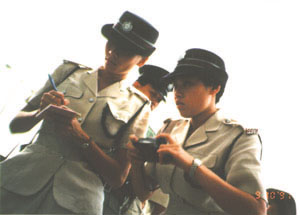 Civil rights
Civil rightsProtestors, police struggle for balance of power in protests



 Civil rights
Civil rights
Protestors, police struggle for balance of power in protests
byPearl Lee

She said her aim of joining the demonstration of the Kingland Apartments rooftop dwellers was merely to talk to Housing Branch officers.
However, the atmosphere became tense when the protesters were barred by the guards of the Citybank Tower from entering Housing Branch office on the ninth floor.
“Police, instead of acting as a mediators, used force to help the guards to prevent protectors’ access to the office,” said Miss Lai, who was arrested for assault after the confrontation broke out.
This is only one of the many examples of conflicts between demonstrators and police. Other examples include the memorial activities of the June Fourth Incident, and demonstrations of workers and residents of the temporary housing.
Miss Lai said that bad strategy by police and the Public Order Ordinance, which provides for expanded power of police during demonstrations, were the main causes of trouble.
The ordinance is more than 25 years old. Except for recent amendment of some specific terms, the latest version of Public Order Ordinance was issued in November 1967.
At that time, organized riots in the form of strikes, bomb attacks and Maoist propaganda challenging British colonial rule and spread by Communists, were considered great threat to local security and stability.
According to the Public Order Ordinance, every public meeting of more than 30 people requires a licence from police. The route and location of protests can be ordered to change. Restricted areas can be set up, and any violation of the ordinance can lead to a criminal offence.
However, many protestors, including Miss Lai, claim that the right of organizing and participating in peaceful assembly is granted by the Bill of Rights. They therefore only “inform” police by telephone or by letter, rather than applying for a license.
Mr. Dick Lee Ming Kwai, assistant commissioner of police for operations, however, said that the system was set up to reduce inconvenience caused to others, and to maintain peace and public order and ensure the safety of the majority.
According to him, this is done with the help of police, which includes special arrangement of traffic, maintenance of order and discussion with the petitioners about the location of protests.
“The number of police officers allocated depends on how tense the confrontation is,” Mr. Lee said.
 He took the demonstrations held on the October 1 every year as an example.
He took the demonstrations held on the October 1 every year as an example.
“The police not only pay attention to the protestors, but also to the 3,000 guests. Their burden is even heavier when the protestors are passionate. Then, more police officers are required,” he said.
“Police remain neutral in regulating demonstrations. We do not lean toward the government’s side,” he said.
Concerning recent confrontations, he pointed out that the difference in standpoints was the main cause of conflicts. While the police wanted to fulfil their duty, the protestors were eager to express their opinion.
Said Mr. Lee: “Some protestors even deliberately stir up trouble to gain sympathy from the media.” However, Miss Yuen Fun, a social activist, said that those troubles were often caused by the police.
“For instance, when the protestors cross the road according to road regulations, no disturbance is caused.
“But with the involvement of police who block the road without referring to the traffic conditions, congestion results,” she said.
“Basically, every protestor respects law and order, and no one would deliberately cause trouble.
“Moreover, the police said they try to help. Yet, actually, they already have a biased assumption against the demonstrators — they are irrational, trouble-making and ignorant of how to act responsibly,” she said. “It is a humiliation to the protestors.”
Moreover, she said the police could not possibly be neutral. “The police can only look from their positions for assessing whether a protest endangers public order.”
Miss Lai held a similar view.
She regarded taking videos and photographs by the police during demonstrations as a “terrible act”. She said, “The tapes can be used to bring a suit against the protestors.”
Mr. Lee admitted that this could be true, but claimed that it was advantageous to both sides because all the things recorded were true, and that if the tapes are not used in three months, they are destroyed.
Yet, a duration of three months is long enough for the police to identify active protestors. Miss Yuen said that they did not consider the videotapes as a threat to them until the arrest of three protestors during the Kingland rooftop issue.
“To stem down the protest, the most efficient way is to arrest active protestors. Active protestors can best be identified from videotapes recording previous action of the same group of people,” Miss Yuen said.
According to Miss Lai, some undercover detectives once tried to eavesdrop on their conversation in a meeting.
Facing criticisms, Mr. Lee emphasized that the equal distribution of authority and norms, with the external monitoring force of the Police Complaints Committee and the media, were enough to balance the power of the police.
“We totally respect basic human rights, and we do not want to have any conflicts with the protestors,” he said.
Miss Lai simply did not agree with this, however.
“If basic human rights are not based on power, but on people in power, bad influence to community development will result,” Miss Lai said.


